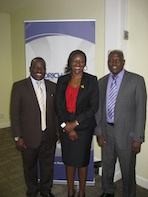Thursday, April 18, 2024
News and Views from the Global South
AFRICA: Tripartite Free Trade Plan May Repeat Previous Mistakes
Servaas van den Bosch
- With regional wheels rolling to put in place the envisaged grand tripartite free trade area (FTA), questions have arisen about whether it would be viable and increase competitiveness.

l-r: Tarah Shaanika (NCCI), Paulina Elago (Trade Mark East Africa) and Paul Kalenga, trade policy advisor, SADC Secretariat. Credit: Servaas van den Bosch/IPS
“Trade between the region and China, for instance, shot up with 500 percent in the past few years, but intra-regional trade is still proportionally low, despite all the efforts around a Southern African Development Community (SADC) FTA,” he said.
Experts from different countries in the envisaged tripartite FTA gathered on Apr. 20 in the Namibian capital to discuss the readiness of smaller nations in the region to engage in the scheme.
The alliance would unite three existing regional economic communities (RECs): SADC, the East African Community (EAC) and the Common Market for Eastern and Southern Africa (COMESA). The FTA would encompass 26 countries and 521 million consumers.
But doubt was discernable on the benefits of the grand FTA and whether it will automatically lead to economic growth.
“Our policy makers have not asked the question: is this viable for our region? The FTA should be about more than removing tariffs, it should build competitiveness,” mooted Kalenga.
“Efforts are mostly geared towards removing tariff barriers, but how can the tripartite FTA be designed in a way that removes remaining non-tariff barriers?”
“In the negotiations, officials have a tendency to list everything that a country produces as ‘sensitive’. These products are then excluded”, meaning that whole sectors are not part of the free trade regime, explained Kalenga.
“Today SADC doesn’t even trade in wheat flour on a preferential basis because the member states cannot agree on the rules of origin. A tripartite FTA based on that methodology is not going to be meaningful.
“Countries should not be allowed to simply exclude whole sectors from a FTA. They should justify exclusions on the basis of development policies. But this is a sensitive issue. When we spoke to Zambian farmers about removing agricultural tariff barriers, we almost got thrown out of the room.”
According to Kalenga the answer lies in designing the FTA in a way that stimulates trade creation through specialisation; benefitting from comparative advantages; and increasing efficiency and productivity. “Look at Botswana that has specialised in services, including medical services and finance. Namibia could also specialise and use the port of Walvis Bay to establish itself as a transport hub.”
So far a clear vision beyond mere tariff liberalisation seems lacking in the region.
“What we lack in most countries are clear industrial policies on which to base our vision of regional economic integration,” said Tarah Shaanika, chief executive officer of the Namibian Chamber of Commerce and Industry (NCCI).
“Instead of listing sensitive products, we should build on success stories like Namibia Breweries that exports its beers all over the continent. There is also too much emphasis on the manufacturing sector while growth in services is huge. We should strategically develop the services sector.”
“Intra-regional trade has gone up from seven billion dollars in 2002 to 27 billion dollars in 2007,” noted Paulina Elago, Tanzania country director for Trade Mark East Africa.
“But are we developing sectors from a strategic point of view?” she asked, taking the port of Walvis Bay and its transport corridors as an example. “Are such initiatives embedded in the national development agenda? Is the infrastructure at the port of a standard that could back up the ambition of being a transport hub?
“Similarly, countries should look at services in a much more strategic way. Services are important, but there is no guarantee the FTA will make these sectors suddenly work. We should look at services that truly add value in the African context, such as transport, energy, logistics and banking.”
Elago added that, “readiness to engage with the opportunities the tripartite FTA offers has to do with many factors, including understanding the business environment in the different countries. Exporters need first-hand information about export destinations.”
Commenting on the haste with which the tripartite FTA is being pushed through – with a planned mid- 2011 meeting expected to lay down the blueprint for the bloc – Elago said: “Often we get excited about these FTAs and set unrealistic timelines.
“SADC right now does not work because we designed rules of origin that we cannot adhere to. It’s very important that the analytic work for this FTA is done properly.”
Namibian economic analyst Klaus Schade argued that many growth objectives could be achieved without the FTA. “Look at the example of Namibia Breweries. They achieved their market presence without bilateral trade agreements.”
“It’s not true that we will only achieve growth with free trade agreements or customs unions. It is very much up to the private sector to come up with initiatives and also look at countries outside the proposed grand FTA,” Schade added.
“To develop Namibia as a transport hub we do not need South Sudan or Djibouti. Maybe we should rather focus on providing a feeder service for West Africa, or develop the maintenance facilities at the Walvis Bay port.”
Elago has the last word: “The tripartite FTA will not solve everything, but it might encourage policy measures at the broader level.”

 Print
Print



